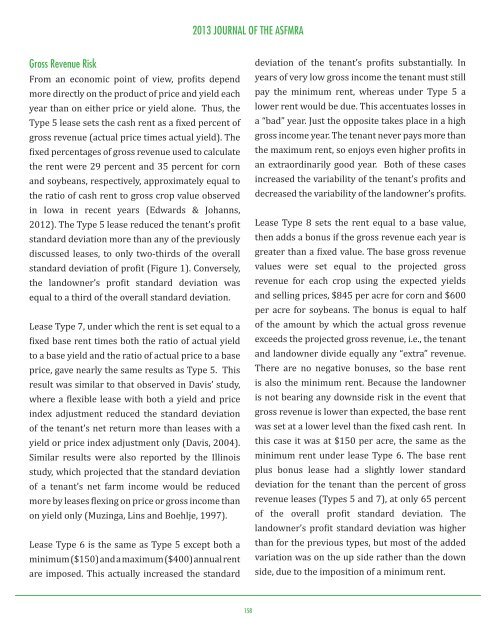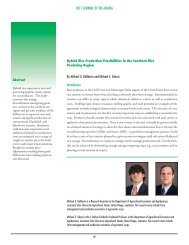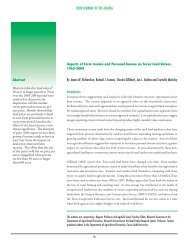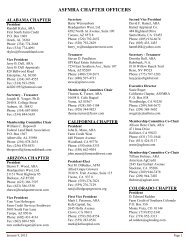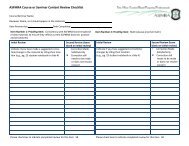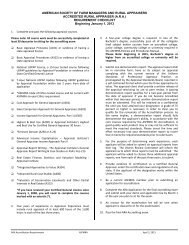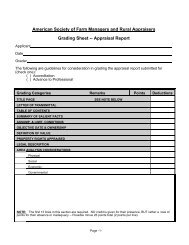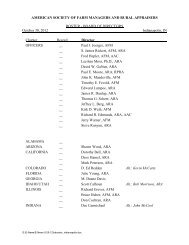Sharing Financial Risk through Flexible Farm Lease Agreements
Sharing Financial Risk through Flexible Farm Lease Agreements
Sharing Financial Risk through Flexible Farm Lease Agreements
Create successful ePaper yourself
Turn your PDF publications into a flip-book with our unique Google optimized e-Paper software.
2013 JOURNAL OF THE ASFMRA<br />
Gross Revenue <strong>Risk</strong><br />
From an economic point of view, profits depend<br />
more directly on the product of price and yield each<br />
year than on either price or yield alone. Thus, the<br />
Type 5 lease sets the cash rent as a fixed percent of<br />
gross revenue (actual price times actual yield). The<br />
fixed percentages of gross revenue used to calculate<br />
the rent were 29 percent and 35 percent for corn<br />
and soybeans, respectively, approximately equal to<br />
the ratio of cash rent to gross crop value observed<br />
in Iowa in recent years (Edwards & Johanns,<br />
2012). The Type 5 lease reduced the tenant’s profit<br />
standard deviation more than any of the previously<br />
discussed leases, to only two-thirds of the overall<br />
standard deviation of profit (Figure 1). Conversely,<br />
the landowner’s profit standard deviation was<br />
equal to a third of the overall standard deviation.<br />
<strong>Lease</strong> Type 7, under which the rent is set equal to a<br />
fixed base rent times both the ratio of actual yield<br />
to a base yield and the ratio of actual price to a base<br />
price, gave nearly the same results as Type 5. This<br />
result was similar to that observed in Davis’ study,<br />
where a flexible lease with both a yield and price<br />
index adjustment reduced the standard deviation<br />
of the tenant’s net return more than leases with a<br />
yield or price index adjustment only (Davis, 2004).<br />
Similar results were also reported by the Illinois<br />
study, which projected that the standard deviation<br />
of a tenant’s net farm income would be reduced<br />
more by leases flexing on price or gross income than<br />
on yield only (Muzinga, Lins and Boehlje, 1997).<br />
<strong>Lease</strong> Type 6 is the same as Type 5 except both a<br />
minimum ($150) and a maximum ($400) annual rent<br />
are imposed. This actually increased the standard<br />
deviation of the tenant’s profits substantially. In<br />
years of very low gross income the tenant must still<br />
pay the minimum rent, whereas under Type 5 a<br />
lower rent would be due. This accentuates losses in<br />
a “bad” year. Just the opposite takes place in a high<br />
gross income year. The tenant never pays more than<br />
the maximum rent, so enjoys even higher profits in<br />
an extraordinarily good year. Both of these cases<br />
increased the variability of the tenant’s profits and<br />
decreased the variability of the landowner’s profits.<br />
<strong>Lease</strong> Type 8 sets the rent equal to a base value,<br />
then adds a bonus if the gross revenue each year is<br />
greater than a fixed value. The base gross revenue<br />
values were set equal to the projected gross<br />
revenue for each crop using the expected yields<br />
and selling prices, $845 per acre for corn and $600<br />
per acre for soybeans. The bonus is equal to half<br />
of the amount by which the actual gross revenue<br />
exceeds the projected gross revenue, i.e., the tenant<br />
and landowner divide equally any “extra” revenue.<br />
There are no negative bonuses, so the base rent<br />
is also the minimum rent. Because the landowner<br />
is not bearing any downside risk in the event that<br />
gross revenue is lower than expected, the base rent<br />
was set at a lower level than the fixed cash rent. In<br />
this case it was at $150 per acre, the same as the<br />
minimum rent under lease Type 6. The base rent<br />
plus bonus lease had a slightly lower standard<br />
deviation for the tenant than the percent of gross<br />
revenue leases (Types 5 and 7), at only 65 percent<br />
of the overall profit standard deviation. The<br />
landowner’s profit standard deviation was higher<br />
than for the previous types, but most of the added<br />
variation was on the up side rather than the down<br />
side, due to the imposition of a minimum rent.<br />
158


